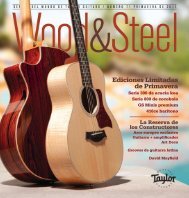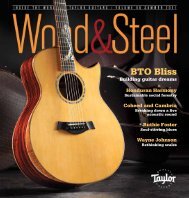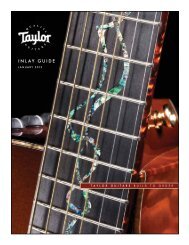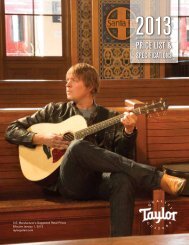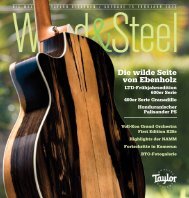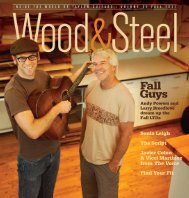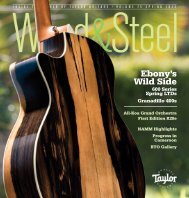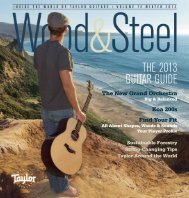Create successful ePaper yourself
Turn your PDF publications into a flip-book with our unique Google optimized e-Paper software.
13<br />
<strong>Tommy</strong> <strong>Shaw</strong> understands<br />
the twinge of skepticism<br />
some might feel upon<br />
hearing that he’s releasing a bluegrass<br />
album. After all, he’s a veteran rock<br />
star, known the world over for his<br />
work with Styx, Damn Yankees and<br />
<strong>Shaw</strong> Blades. Traditional bluegrass<br />
is different turf, where electric guitars<br />
are verboten, and drums border on<br />
heresy. Then again, when you factor<br />
in <strong>Shaw</strong>’s Southern heritage, his love<br />
of acoustic roots music, and the thinair<br />
vocal lines that have gilded hits<br />
like Styx’s “Crystal Ball” and Damn<br />
Yankees’ “High Enough,” maybe he’s<br />
not straying far from his wheelhouse<br />
after all.<br />
That said, <strong>Shaw</strong> himself wasn’t<br />
sure what to expect when he first<br />
dipped his toe into the bluegrass<br />
creek back in 2003. His friend, singersongwriter,<br />
slick-picker and producer<br />
Brad Davis, who’s played with country<br />
luminaries Marty Stuart, Earl Scruggs<br />
and Sam Bush, asked him to sing high<br />
harmony on one of his bluegrass tunes<br />
(“Tell Me Son” from his album I’m Not<br />
Gonna Let My Blues Bring Me Down).<br />
Things clicked, and the two agreed<br />
that they should block out more writing<br />
time together.<br />
They did, bearing creative fruits<br />
that included several song demos they<br />
loved, but years would pass before<br />
the two could synchronize their busy<br />
schedules again. When they finally did,<br />
starting in late 2009, the outpouring<br />
was prolific. On the eventual result,<br />
<strong>Shaw</strong>’s new record, The Great Divide,<br />
the two unfurl a heartfelt homage to<br />
the bluegrass spirit, guided by lyricrich<br />
story-songs that marry a compact<br />
song structure — the tunes rarely stray<br />
from the three-minute mark — with<br />
soulful, intricately woven acoustic<br />
instrumentation flavored with tasty<br />
bluegrass breakdowns. <strong>Shaw</strong> and<br />
Davis co-produced (along with singersongwriter<br />
and <strong>Shaw</strong> Blades member<br />
Will Evankovich), and <strong>Shaw</strong> also<br />
co-wrote a few tunes with songwriting<br />
stud Gary Burr (815c, 612c), who’s<br />
penned hits for the likes of Randy<br />
Travis, LeeAnn Rimes, and George<br />
Jones, and co-written with Ringo Starr,<br />
Carole King, Mary Chapin Carpenter,<br />
and John Levanthal.<br />
For the recording sessions, <strong>Shaw</strong><br />
and Davis enlisted a Nashville dream<br />
team, including Sam Bush (mandolin),<br />
Byron House (bass), Rob Ickes<br />
(Dobro), Scott Vestal (banjo), Stuart<br />
Duncan (fiddle), and Chris Brown<br />
(drums), with a guest spot on Dobro<br />
from Jerry Douglas and vocal cameos<br />
from Dwight Yoakam and Alison<br />
Krauss.<br />
Chatting by phone from his home<br />
in the Hollywood Hills on a midmorning<br />
in early March, <strong>Shaw</strong> reflects<br />
on the wellspring that informed the<br />
project — the roots-rich music he<br />
heard on the radio growing up in<br />
Montgomery, Alabama, including<br />
Grand Ole Opry broadcasts from the<br />
AM station WSM in Nashville.<br />
“Back in the ’60s, cars had the big<br />
bench seats before the days of seat<br />
belts,” he remembers. “I would stand<br />
up on the seat and lean over the front<br />
and listen to the radio and hear all this<br />
great music. This record was like my<br />
version of what the radio felt like back<br />
then.”<br />
With its old school sounds and<br />
narrative lyrical bent, The Great<br />
Divide taps straight into the marrow<br />
of life, as episodes of love, hope,<br />
heartbreak, hard labor, death, and<br />
cross-generational bonding unfold.<br />
The churning, upbeat opener, “The<br />
Next Right Thing,” is fueled by <strong>Shaw</strong>’s<br />
high-spirited vocals, followed by the<br />
playful pleas of the double-entendreladen<br />
“Back in Your Kitchen.” In<br />
“Sawmill,” <strong>Shaw</strong> draws from his<br />
father’s account of working as a water<br />
boy at a logging camp and witnessing<br />
a logger’s gruesome, accidental death.<br />
The title track is a poignant waltz<br />
in which finding a grandfather’s old<br />
letters to his wife helps salvage the<br />
narrator’s own troubled relationship.<br />
In “Shadows in the Moonlight,” secret<br />
love meets tragic consequences. The<br />
earthy porch-stomper “Umpteen Miles”<br />
chronicles Davis’s rock-hauling father.<br />
The re-affirming “Afraid to Love” is<br />
another multi-generational tune buoyed<br />
by a beautiful harmony from Alison<br />
Krauss. The quirky wild card of the<br />
batch, the spare, fingerpicked “Give<br />
’em Hell Harry,” channels vintage John<br />
Prine.<br />
The fact that the album packs such<br />
evocative musical stories into less<br />
than 40 minutes is a tribute to <strong>Shaw</strong><br />
and Davis’s ability to distill down to a<br />
level of simplicity without losing the<br />
richness of the vocal and instrumental<br />
arrangements. Blending timeless<br />
themes, personal stories, and indelible<br />
melodies helps these songs resonate<br />
in a way that, like other great roots<br />
music, is built to live on.<br />
In our conversation, <strong>Shaw</strong> elaborates<br />
on his musical roots, the importance of<br />
co-writing chemistry, and his rekindled<br />
love of vinyl records.<br />
Congratulations on getting the<br />
record across the finish line. It<br />
must have felt good after having<br />
been in the works for a few years<br />
now.<br />
It did. You know, it just kept picking<br />
up momentum. It started out with just<br />
Brad and me doing these demos, but<br />
then as the songs came together, all<br />
of a sudden we had enough to make<br />
a really good record, and then we<br />
kind of overwrote it once my friend<br />
Gary Burr became available. We even<br />
knocked some of Brad and my songs<br />
off because they just kept getting<br />
better. It just kept demanding that we<br />
be the stewards and usher this thing<br />
along, so it was like it was leading us.<br />
Those are the best records — the ones<br />
where you wake up and you know the<br />
next thing to do.<br />
In your blog documenting this<br />
project, you wrote about nursing<br />
songs along: “One of the things<br />
I enjoy most about creating an<br />
album’s worth of songs is to have<br />
a big batch of songs in various<br />
stages of completion, and let them<br />
tell you what’s next.” Can you<br />
elaborate on that?<br />
Well, when I start getting a batch<br />
of them together, I like to get the<br />
foundations set up so you kind of<br />
know what the song’s gonna do, so<br />
you can really follow your heart and<br />
what’s inspiring you that day. With me,<br />
I’ll wake up and just be lying there,<br />
and all of a sudden I’ll hear what the<br />
song needs to do — this is the lyric;<br />
Sullivan Show. I always loved Sammy<br />
Davis, Jr. I was never stuck in one kind<br />
of music. Later, I’d be in bands where<br />
one would be playing lounge music,<br />
and one would be playing soul music,<br />
and I just loved all of it, because I was<br />
never restricted. So, to hear Ralph<br />
Stanley and that high voice when I<br />
was a little kid, then you’d hear guys in<br />
gospel groups and hear the guy with<br />
the high voice. It always fascinated<br />
me, all the harmonies.<br />
Did other people in your family<br />
sing?<br />
My mother liked to sing gospel; she<br />
liked to sing the hymns and things like<br />
that. She plays piano a little bit by ear<br />
and actually plays harmonica, too, by<br />
ear. She and I will still get together<br />
and jam with her on harmonica. She’s<br />
my musical muse from the family.<br />
You sang high harmony with Brad<br />
back in 2003 on a bluegrass tune<br />
of his. How did you guys first get<br />
together?<br />
I met him after I went to the Hank<br />
Williams tribute concert at the Rock<br />
& Roll Hall of Fame museum in 2002,<br />
and Billy Bob Thornton was there and<br />
“To hear Ralph Stanley and that<br />
high voice when I was a little kid,<br />
then you’d hear guys in gospel<br />
groups and hear the guy with the<br />
high voice. It always fascinated me,<br />
all the harmonies.”<br />
this is what needs to happen next;<br />
this is what I wanna play. So, you<br />
go out and focus on that one until it<br />
settles down, and then you’ll hear an<br />
idea for another song, so you can just<br />
switch from one to another, like you’re<br />
building this little neighborhood and<br />
you’ve got all the little foundations that<br />
you have the luxury of not having to<br />
submit any plans for. You just go out<br />
there and free-form build these little<br />
works of art.<br />
Take me back to your formative<br />
days. What kind of musical<br />
environment did you grow up in?<br />
My family loved all kinds of music,<br />
so we never heard, “I hate that kind<br />
of music.” I think the first time I ever<br />
heard that was from my father when he<br />
heard the Four Seasons do “Sherry”—<br />
that falsetto was the one thing that<br />
put him over the top [laughs]. But<br />
everything else, we just loved all kinds<br />
of good music — the Grand Ole Opry,<br />
Johnny Cash. We would watch The Ed<br />
Marty Stuart. I’d met Marty before, but<br />
because Billy lives here in L.A., we<br />
wound up going over to his house.<br />
He’d bought Slash’s old house, which<br />
has a big studio, so he had his band<br />
down there working on a new record,<br />
and Brad was in Billy’s band. So Brad<br />
heard me singing high, I think on one<br />
of Billy’s songs, and he said, “Would<br />
you consider singing a high part on<br />
this bluegrass thing?” And that’s how<br />
it came about. Once I did it, he said<br />
we oughta get together and try writing.<br />
The next time he was in town he<br />
came over, and it happened so easily.<br />
We wrote the song “I’ll Be Coming<br />
Home” and demo’d it. Problem was, I<br />
was busy touring with Styx and <strong>Shaw</strong><br />
Blades, so there was never really time<br />
to get together again until the next<br />
year, and then we wrote “Afraid to<br />
Love” and loved how that came out.<br />
Both songs ended up on the record.<br />
So, it started slowly like that. Then in<br />
2009 — we have to plan our schedules<br />
months in advance — all of a sudden<br />
there was this hole in my schedule,<br />
same with Brad, so our wives said,<br />
“You should both do this now.” And<br />
when the girls say that, you know<br />
you’re in good shape. Once we did<br />
that, the floodgates opened up, and it<br />
was like this record was just dying to<br />
be born.<br />
Story-songs are often a strong<br />
component of roots music. The<br />
“Sawmill” tune comes out of your<br />
own family history. What about<br />
some of the other stories?<br />
Well, Brad had the first verse written<br />
for the song “Umpteen Miles,” and that<br />
really struck a nerve with me, but that’s<br />
a story of him and his father. That was<br />
the third thing that we did. I helped<br />
him finish that one. And that’s still one<br />
of our favorites. “Umpteen” is one of<br />
those words that’s kind of made up,<br />
but both of us absolutely knew what<br />
it meant. So those songs just kept<br />
coming.<br />
Another good one is “Shadows in<br />
the Moonlight.”<br />
Yeah, that was when Gary Burr came<br />
into the picture. I’ve known Gary since<br />
1995. We went to Jakarta together<br />
and did a songwriter festival there,<br />
and Jack [Blades] and he and I got<br />
together at some point and co-wrote<br />
a song, and we’d always meant to<br />
get back together again, but it never<br />
happened. I finally sent him some of<br />
the demos and he got back to me<br />
and said, “I’m in!” It still took a while<br />
for him to find some time to come out<br />
here, but once he did, “Shadows in<br />
the Moonlight” was the first thing we<br />
wrote.<br />
You had an interesting comment<br />
about working with him on the<br />
song “Back in Your Kitchen.” I think<br />
you got stuck at one point. Can you<br />
talk about how you guys worked<br />
together and how co-writing with<br />
a good partner can help you get a<br />
song done?<br />
I had the song idea, but it just didn’t<br />
have the right feel. And Gary is such a<br />
genius. I had some of the lyrics written<br />
out like that, and he took it all in, then<br />
said, “What if we did it this way?” and<br />
he just sat down and played it with<br />
that kind of two-step beat, and all of<br />
a sudden, there’s the song that you<br />
hear. It happened so fast because he<br />
didn’t have any preconceived notions.<br />
I’d kind of spun it around in my head<br />
too many times. And he heard it fresh<br />
and basically played it back to me in a<br />
way that made sense. When you have<br />
chemistry with a songwriter, that’s<br />
what you do with each other, you kind<br />
continued next page




